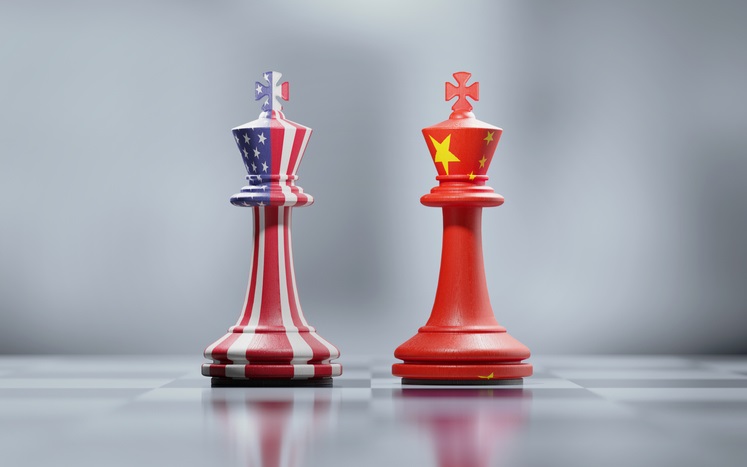US shares and Chinese bonds: the new 60/40 portfolio?
A strategist explains why investors might want a portfolio split between US stocks and Chinese bonds.
29th June 2021 12:44
by Tom Bailey from interactive investor
A strategist explains why investors might want to consider a portfolio split between US stocks and Chinese bonds.

Over the past decade, the US stock market has roared ahead, while bond prices have continued to rise and yields fall. As a result, anyone who has opted for a classic 60/40 stock and bond asset allocation has fared pretty well.
However, according to a new report by Vincent Deluard, director of global macro strategy at StoneX, a US financial services network, investors might want to consider a new sort of 60/40 stock and bond split. In a paper, titled “China is for bonds & the US is for stocks: the new 60/40” Deluard lays out why investors might want a portfolio split between US stocks and Chinese bonds.
Declining births, low growth
Deluard argues that one of the most important macroeconomic facts of the coming decade is the increased ageing of East Asian countries. Countries such as South Korea, Taiwan, Thailand and China all experienced a boom in births in the 1970s. In the 1990s, those born in this baby boom entered the workforce, contributing to the region’s rapid economic rise.
Since then birth rates have severely slowed. While in China this was the result of the one-child policy, a similar collapse in birth rates has been seen throughout East Asia, where such restrictions were not in place. The average Korean woman is expected to have less than one child in her life.
As Asian societies age, Deluard argues, economic growth will slow. He says: “The slowdown in growth will be massive. Growth is the result of labour, capital, and an unexplained residual called productivity. Robotisation, heavy research and development investment, and large savings pool will not be able to offset the collapse of Asia’s labour force.”
And this, in turn, will be bad for the performance of shares in the region. He says: “Equities are quintessentially a growth asset. This is especially true in China, where investors must ignore serious issues of corporate governance, government interference, and intellectual property theft to access its large and rapidly growing market.”
He continues: “China’s coming demographic collapse will be a massive headwind for stocks and a huge boost for its government bonds, which already pay the highest real yield in the world.”
- Factor or sector ETFs: which were best for riding the value rally?
- The ETFs Show: what you need to know about investing in China
- The best ETFs to access China’s exciting tech industry
Deluard says that Japan offers somewhat of a blueprint for this, with the country having already gone through demographic ‘collapse’ and a huge slowdown of growth since the 1990s. He notes that Japanese government bonds overperformed Japanese equities, measured by the Nikkei-225 Index, by 100% in the following three decades. If other East Asian countries tread the same path of slow economic growth and rapid ageing, asset returns may look similar.
He argues: “The coming collapse of China’s nominal growth will boost the returns of its government bonds, which are already offering exceptionally positive real rates.”

What does the Party want?
However, beyond this, there are the specific policy choices of the Communist Party of China. First, he argues that the Chinese government is fixated on ensuring China’s currency gains more international use, potentially one day supplanting the US dollar as the world’s global currency.
Whether China will succeed in this, this goal will motivate authorities to ensure the yuan is seen as a strong and rising currency. He says: “China needs the world to trust that Chinese government bonds will be the best store of value in the next decades.”
When it comes to Chinese shares, Deluard draws parallels with another emerging market: post-Soviet Russia. In 1990s Russia, a group of businessmen emerged as powerful political actors after taking control of the country’s recently privatised industry, and came to be collectively referred to as ‘oligarchs’. Mikhail Khodorkovsky, the owner of oil and gas firm Yukos, was among the most prominent. However, after Vladimir Putin became president in 2000, the power of these businessmen, collectively referred to as oligarchs, was gradually curtailed.
- Why you should consider a Chinese bond ETF
- China stock market surpasses $10 trillion – why is it rallying?
- Tech crackdown creates sizeable gap in Chinese ETF performance
This reached a dramatic climax in 2003 when Khodorkovsky was arrested. Deluard describes it as such: “The oligarch was jailed, his company was broken up, and Russian energy stocks, which traded at a premium to their global peers during the reform era, were punished by a permanent discount.”
Deluard sees parallels with China’s recent tech crackdown. Most notably, he points to the abrupt cancellation of Ant Financial’s $37 billion IPO last year and the ensuing temporary “disappearance” of Alibaba’s Jack Ma. He does not see this event as a one-off. He argues: “Communist Party of China members view tycoons with a mix of envy and scorn. Too much private wealth is seen as a threat to the primacy of the party.”
With this in mind, Deluard says: “The recent crackdown against Chinese tech platforms could do to Chinese stocks what the Khodorkovsky trial did to Russian equities: a permanent de-rating of multiples.” He refers to the admonishment of Jack Ma as China’s ‘Yukos Moment’.
Stock market is not that important
Another problem, in Deluard’s view, is that the Chinese stock market is simply not that important. The total market capitalisation of Chinese equities is equal to 83% of GDP. In comparison, the US’ is worth 181% of its GDP. A popular interpretation of this is to assume China’s stock market will continue to grow and catch up with US levels.
Deluard, however, has a different view. Instead, he sees the relatively small size of the Chinese stock market as a vulnerability: “The stock market is not that important, especially for politicians who derive most of their wealth from real estate and their power from guanxi (personal connections).” As a result, it is not a priority that is guiding government policy.
In contrast, he argues that stock market performance is systemically important to the US. One piece of evidence for this is the reaction to the US Federal Reserve in the 2018 market sell-off. This sell-off was precipitated by the Federal Reserve raising interest rates and the outcome was a halt in further rate rises. This suggests the central bank now views stock market performance as one part of its mandate, even if it is not officially stated.
Another reason why stock prices are systematically important in the US is the make-up of stock ownership. Deluard argues: “Institutional investors own 72% of the US stock market. A bear market becomes a political problem when it devastates banks, insurers and pension funds, and prevents voters from achieving their retirement goals.
“Conversely, China’s stock market is dominated by gambling-prone retail investors. Asking the government for bailouts is seen as absurd as asking the house for a refund after a bad night in Macao.”
This, among other reasons, means the Federal Reserve will likely not raise rates too fast in the face of inflation, which will potentially continue to support US equity valuations.
- Diversifying your portfolio is easy with these ii Super 60 recommended funds
- Take control of your retirement planning with our award-winning, low-cost Self-Invested Personal Pension (SIPP)
Beyond this, he argues that other US government policies are also potentially in line with a more relaxed view of inflation. He says: “Inflation, financial repression and a weak dollar are necessary to restore the US manufacturing base, solve its debt crisis, and reduce wealth inequalities.”
However, the other side of this is that inflation will continue to mean negative real returns for US bond holders.
Another consideration for a bullish attitude towards US stocks is the prospect of the large US tech companies continuing to maintain their monopolistic positions. Deluard says: “Big tech stocks’ valuations may never normalise if they retain their monopolistic margins.” He contrasts the US’ apparent reluctance to break up big tech monopolies with the recent actions of Chinese authorities, mentioned above.
The new 60/40
So what’s an investor to do? According to Deluard: “They can have the best of both worlds by owning US stocks and Chinese government bonds.” He continues: “Buy the bonds of (stable) dictatorships and buy the equities of (powerful) democracies. In other words, China is for bonds and the US is for stocks. Call it the new 60/40.”
The report from StoneX did not give any suggestion of how to implement such a portfolio, nor did it endorse any specific funds or stocks for doing so.
However, it would be relatively easy for an investor to do so with index funds and exchange-traded funds (ETFs). For the US stock exposure, investors could use the Vanguard US Eq Idx £ Acc, which is part of interactive investor’s Super 60 list of investments. For the Chinese bond exposure, there is the iShares China CNY Bond ETF USD Dis GBP (LSE:CNYB). Of course, investors should think very carefully about whether they truly want a portfolio composed of 40% Chinese bonds given the lack of country diversification.
These articles are provided for information purposes only. Occasionally, an opinion about whether to buy or sell a specific investment may be provided by third parties. The content is not intended to be a personal recommendation to buy or sell any financial instrument or product, or to adopt any investment strategy as it is not provided based on an assessment of your investing knowledge and experience, your financial situation or your investment objectives. The value of your investments, and the income derived from them, may go down as well as up. You may not get back all the money that you invest. The investments referred to in this article may not be suitable for all investors, and if in doubt, an investor should seek advice from a qualified investment adviser.
Full performance can be found on the company or index summary page on the interactive investor website. Simply click on the company's or index name highlighted in the article.